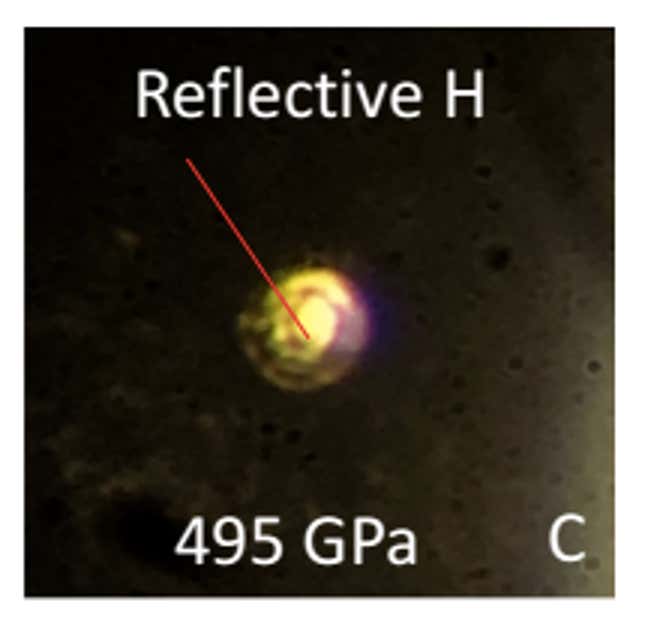Back in January, Harvard physicists Isaac Silvera and Ranga Dias published a paper (paywall) in which they said they had solved an 80-year-old problem: They had found a way to take hydrogen, a chemical that is normally a gas, and turn it into a reflective, possibly superconducting, metal.
It’s not easy to manipulate chemicals to change their physical state. In this case, Silvera and Dias had to squash a tiny sample of nearly frozen hydrogen between synthetic diamonds that had been treated with sapphires to make them impermeable to gas at pressures almost 5 million times the atmospheric pressure we experience at sea level.
Because their sample was merely microns (a fraction of a millimeter) big, they couldn’t actually test if the hydrogen was metal—but it reflected light like one, according to their observations, so they claimed it was.

Last week—just about a month after the original announcement—the team said the sample went missing. The discovery of a physical embodiment of a prediction from 1935 really needs to stay physical in order for others to verify it really happened. “It’s either some place at room pressure, very small, or it just turned back into a gas,” Silvera told ScienceAlert. “We don’t know.” (Quartz has reached out to Silvera for comment, but he hasn’t responded yet.)
Even though the paper published in Science (widely regarded as a reputable journal) had, presumably, gone through the standard vigorous vetting process by other scientists in the field, many outside experts said there wasn’t enough evidence to back up its claim. “If they want to be convincing, they have to redo the measurement,” Paul Loubeyre, a physicist at France’s Atomic Energy Commission in Bruyères-le-Châtel, told Nature at the time the paper was published. Loubeyre thinks the Harvard duo failed to account for how much pressure was actually within their squeezing system—and that a picture with a single measurement alone isn’t enough to say that it really happened.
False claims of metallic hydrogen have been made before. In 2012, researchers at the Max Planck Institute for Chemistry in Germany reported they’d made the theorized element, but later admitted they overstated the claim. “Our measurements are not perfect,” Mikhail Eremets, a physicist who worked on the 2012 paper, told Nature. Perhaps, he said, they should have only said they may have created metallic hydrogen.
As Gizmodo points out, it’s impossible to say whether the metallic hydrogen was lost, or never existed to begin with. But the fact that the only known sample of it has gone missing, compounded by earlier doubts that metallic hydrogen is attainable, suggests maybe this physics milestone hasn’t yet been reached.




